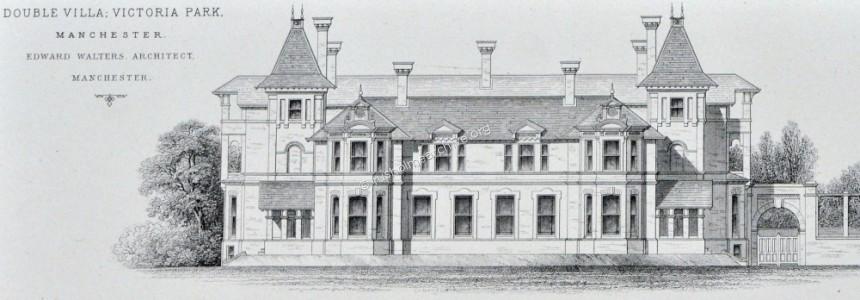Rusholme & Victoria Park Archive
'A background to the family names & Birch Hall'
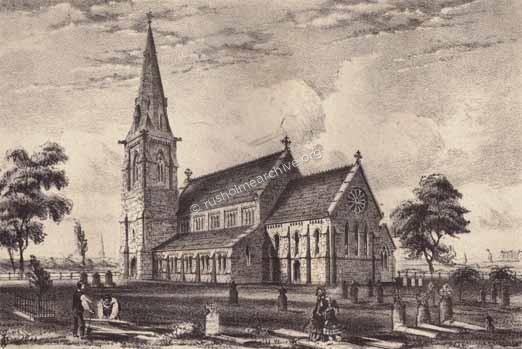
Birch-in-Rusholme does seem to be a slightly old-fashioned name for the SE part of Rusholme that is clustered broadly around the above and now redundant church of St James.
In this website the border will be defined geographically as a starting point of the junction of Wilmslow Road & Dickenson Rd, easterly along Dickenson Rd to Anson Rd; then along Birchfields Rd to Old Hall Lane; then in a westerly direction down Old Hall Lane; and then finally along Wilmslow Rd to the starting point at Dickenson Rd.
Historically the name relates to the Birch family who in the 12th century acquired lands in this area and subsequently built Birch Hall and the small family Birch Chapel.
Several of the Birch family are said to have distinguished themselves in the French wars of the 15th century, but its most noteworthy member was Colonel Thomas Birch, a Puritan and Parliamentarian of a somewhat brutal type, who took an active part in the Civil War in Lancashire. He was made Governor of Liverpool on the recapture of the town in 1644, and represented it in Parliament from 1649 to 1658. On the Restoration he retired into private life, and was in 1678 succeeded by his son Thomas Birch the antiquary, Thomas's son died without issue, and his brother, Dr. Peter Birch, a prebendary of Westminster, came into possession.
He died in 1710, and his son Humphrey, sold the Birch estate to a Manchester merchant, George Croxton for £6000 in 1743.
Two years later the estate was acquired by John Dickenson, another well known Manchester merchant.
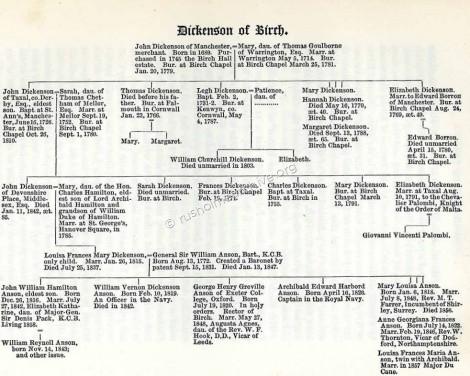
A very comprehensive account of the history of and pedigree of the Birch family was published in a 240 page book by the Lancashire & Cheshire Antiquarian Society in the late 1870s:
'A History of the Ancient Chapel of Birch: In Manchester Parish, Including a Sketch of the Township of Rusholme, for the Convenience of Which Township the Chapel Was Originally Erected: Together with Notices of the More Ancient Local Families', by John Booker.
This book has been digitally copied and is now available to read on-line from the Google library.
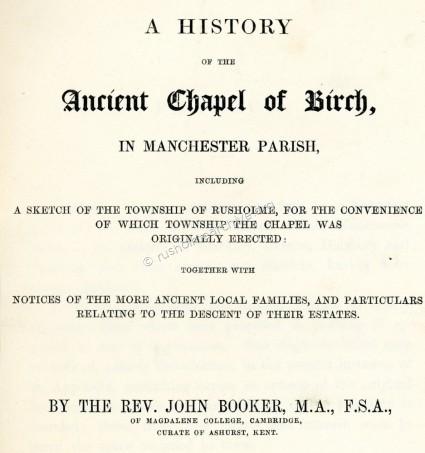
The Anson family. Motto: Nil desperandum (Never despair)
In 1815 the great-granddaughter of John Dickenson, Louisa, the last of the family line, then married General Sir William Anson, 1st Bart. thus beginning the connection with the Anson family.
The Anson family did not take up residence at Birch Hall. Entries in the census survey and voters lists indicate that another prosperous Manchester merchant, John Strickland & his family rented the Hall.
It was the Anson family who probably left the biggest impression in the district of Rusholme. They owned a very substantial estate and were quite prepared to develop the land, both for ‘social’ purposes and their own financial benefit.
They were already a prosperous family with other estates and the Anson estate in Rusholme is now only a memory of the past commemorated by the name.
Other than his two uncles, George Greville Anson, the incumbent at St James, & Sir Archbold Anson referred to in the next page, it was Sir William Reynell Anson who seemed to be become involved in Rusholme. His family had invested land and money into Victoria Park, and Sir William had a notable clash with the Trustees of Victoria Park when he wanted to build smaller properties and break the 'building tie'. (More about this matter in the pages of Victoria Park - still being written).
He was also quite a generous donor of land and money towards social matters in Rusholme.
The Baronetcy was created in 1831 for the husband of Louisa Dickenson, General Sir William Anson, a notable soldier in the Peninsular war. Remarkably within 87 years five baronets were dead. Below is an account referring to the last four, beginning with Sir William Reynell Anson.
Sir William Reynell Anson, 3rd Baronet PC (14 November 1843 – 4 June 1914), was born in Sussex, the eldest son of Sir John William Hamilton Anson, 2nd Baronet.
Educated at Eton and Balliol College Oxford he took a first class in the final classical schools in 1866, and was elected to a fellowship of All Souls in the following year. In 1869 he was called to the bar, and went the home circuit until 1873, when he succeeded to the Baronetcy, his father, *Sir John Anson, 2nd Bt., having been killed in a railway accident at Wigan.
In 1874, he became Vinerian reader in English Law at Oxford, a post which he held until he became, in 1881, Warden of All Souls College. He identified himself both with local and university interests; he became an alderman of the city of Oxford in 1892, chairman of quarter sessions for the county in 1894, was Vice-Chancellor of Oxford University in 1898–1899, and Chancellor of the Diocese of Oxford in 1899. In that year he was returned, without opposition, as Member of Parliament for Oxford University in the Liberal Unionist interest, and consequently resigned the vice-chancellorship.
In Parliament, he preserved an active interest in education, being a member of the newly created consultative committee of the Board of Education in 1900, and in 1902 he became, Parliamentary Secretary to the Board of Education, a post he held until 1905. Anson was made a Privy Counsellor in 1911.
He took an active part in the foundation of a school of law at Oxford, and his volumes on The Principles of the English Law of Contract (1884, 11th ed. 1906), and on The Law and Custom of the Constitution in two parts, "The Parliament" and "The Crown" (1886–1892, 3rd ed. 1907, pt. 1 .vol. ii.), are standard works.
He died unmarried in June 1914, aged 70. He was succeeded in the baronetcy by his nephew **Denis.
.
Photograph of Sir William Reynell below.
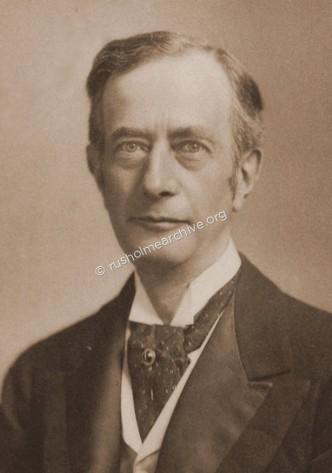
Below an illustation of Sir William in a 'Spy' cartoon and the accompanying biography
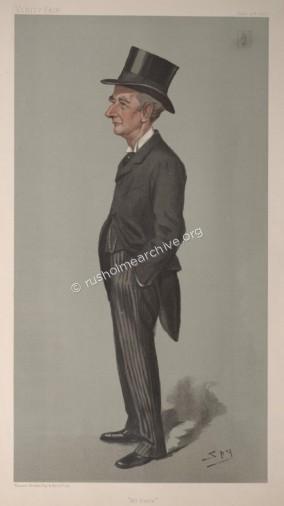
STATESMEN. No. 738.
SIR WILLIAM REYNELL ANSON, BART., M.P.
His grandfather, General Sir William Anson, was created a Baronet to record his distinguished services in the Peninsular War ; besides which he was a brother of Viscount Anson and uncle of the first Earl of Lichfield : so that the Warden of All Souls' (who is the third Baronet) is come of quite a gentle as well as a distinguished House. Himself is eight-and-fifty, though he does not look it. He went from Eton (of which College he is a Fellow) to Balliol, and after he had won a First Class in Greats he was found well born enough and well dressed enough and, indeed, well enough taught, to be elected a Fellow of All Souls'. Then he became a Barrister and a University Reader (Vinerian), and so gradually improved himself into the Warden (or Head) of All Souls' : which is the most comfortable and exclusive Club in the .world. He failed once to get into Parliament as an ordinary Member, but he became an Alderman and a Chairman of County Sessions and a very excellent Vice-Chancellor ; so that he has now succeeded the late Sir John Mowbray as the newest Member for Oxford University. He is quite a learned gentleman who has written much, and lectured more, with lucid ability ; and it is not too much to say that he is one of the greatest authorities living on the Law of Contract, besides being quite a constitutional person who is in receipt of all the Honours that a grateful University can bestow. Yet is he a modest bachelor, an old-fashioned Don, and a sound Tory who labels himself a Liberal-Unionist.
With all his accomplishments he does not obtrude himself upon the public gaze ; for he is quite guiltless of the art of advertising. He has not done, or even said, much at Westminster since he joined that establishment ; but he usually sits with another learned Professor, named Jebb, and looks wiser than any man ever was in reality. Yet he is quite often seen in the Smoking Room of the House, and when bored to distraction he takes refuge in the Inner Library, where " Silence " is enjoined in big letters. Nevertheless, he is bland, amiable, and quite popular with the best part of the House, though his soul is so far removed from the nuances of Parliamentary life and strife that Whips have been accused of refraining from stopping him at the door; while the Sergeant-at-Arms and other Officers of the House do not in the least regard him as a Common Member.
The first University in the World is quite proud of him.
*Sir John William Hamilton Anson, 2nd baronet, (born 26th Dec 1816), together with twelve other men, women and children, was killed in a railway accident at Wigan on 2 August 1873.
The train left Euston for Scotland at 8 p.m. on the night of 2 August 1873. It was drawn by two locomotives and by the time it left Crewe the train consisted of 25 carriages, many of them coaches belonging to wealthy families, including a coach reserved for Sir John Anson.
As the train was running through Wigan station at about 1.20 a.m., the driver noticed that sparks were flying from the rear carriages. Some of the carriages had run up the ramp at the end of the platform, including that which contained Sir John Anson, which stood upon its roof on the platform, with five bodies, including that of Sir John and his valet, scattered around it.
At the subsequent public inquiry into the disaster the inquiry accepted that the train was probably travelling too fast, with the result that one of the carriages had jumped the points, dragging all the other carriages with it. No satisfactory explanation was, however, ever advanced, and the cause of the Wigan crash remains a matter of speculation.
In June 1875, the Anson family successfully sued the London and North-Western Railway for compensation.
**Sir Denis Anson, 4th Bt.(Born 14th August 1888), died within weeks after inheriting the baronetcy from his uncle, Sir William Reynell Anson.
The following note is a report from the New York Times, 9th July 1914;
LONDON, July 8th.,
An Inquest was held today into the death of Sir Denis Anson, the young Baronet who was drowned last Friday after diving into the Thames from a launch in the course of a midnight trip, and the bandsman Mitchell, who lost his life while trying to save Sir Denis.
The testimony showed that there was no foundation for the sensational reports that had been circulated to the effect that something in the nature of an orgy occurred on board.
The jury found that Anson and Mitchell lost their lives by accidental drowning, adding that Anson was “quite sober, but full of fun.”
Lady Diana Manners, a member of the launch party, sat in court with her father and mother, the Duke and Duchess of Rutland. Miss Iris Tree, another member of the party, was also accompanied by her father and mother. Sir Herbert and Lady Tree.
Count Constantin Benckendorff, son of the Russian Ambassador, was the host of the party, which numbered fifteen. Nearly all were present at the inquest, all dressed in mourning. Besides the Count, the members of the party who either gave evidence or were mentioned in the course of the inquiry were Raymond Asquith, son of the Prime Minister; Lady Diana Manners, Miss Iris Tree, Alfred Duff Cooper of the Civil Service, Claude Russel of the Foreign Office, and Jasper Ridley, a brother of Lord Ridley.
The witnesses, strictly questioned on the point, declared that Sir Denis Anson was sober, but high-spirited and merry, the life of the party. He was a good swimmer and once dived from a high building into the Grand Canal at Venice. Only one of his friends was apprehensive of danger when he made his fatal dive. A strong ebb tide with a swirl from o neighboring bridge defeated him, and for three days his body was carried to and fro in the water.
It was a simple and a sad story, said the Coroner, and the jury drafted their verdict while the Coroner was still summing up. They spoke in the highest terms of the heroism of Mitchell and Count Benckendorff, who also dived to the rescue. They and the Coroner expressed satisfaction at hearing that provision was to be made for Mrs. Mitchell and her infant son by the Anson family and the members of the launch party.
One further aspect of this unfortunate story is that Sir Denis lived he would have inherited a very valuable fortune left to him by his uncle. Sir Denis had been left in the will £130,000.00, if you use the statistics on the 'Measuring Worth' website then at today's values that sum can be calculated as shown below.
If you want to compare the value of a £130,000 0s 0d Income or Wealth , in 1914 there are four choices. In 2015 the relative:
historic standard of living value of that income or wealth is £11,250,000.00
labour earnings of that income or wealth is £41,830,000.00
economic status value of that income or wealth is £70,230,000.00
economic power value of that income or wealth is £99,280,000.00
 Sir John Henry Algernon Anson, 5th Bt. died within four years of inheriting the baronetcy. He was born on 13 January 1897 and gained the rank of Lieutenant in the service of the Royal Navy. He died towards the end of the first World War on 2 March 1918 at age 21, lost at sea on board H.M. Submarine H5.
Sir John Henry Algernon Anson, 5th Bt. died within four years of inheriting the baronetcy. He was born on 13 January 1897 and gained the rank of Lieutenant in the service of the Royal Navy. He died towards the end of the first World War on 2 March 1918 at age 21, lost at sea on board H.M. Submarine H5.
The truth about his death did not emerge until many years later, Winston Churchill effectively ordered a cover-up of what was in effect ' friendly fire'.
The H5, a medium-sized coastal defence submarine, was cruising the surface off the coast of Wales when it was rammed by a British merchantman the SS Rutherglen. The Admiralty ordered the Rutherglen to leave the scene. The ship's muster were never told of the mistake and were even given a bounty for sinking what they thought was a German U-boat. The shocking truth only emerged decades later, that all twenty-six crew of the submarine perished, all but one of the victims were British. The other was Lt. Earle Wayne Childs - the first American submariner killed in European and world conflicts. Lt. Childs died while serving as observor aboard the British submarine, H5, when it was struck and went down with all hands.
The Admiralty filed the following message;
'"With regard to the SS Rutherglen, it is submitted that she should not be informed that the rammed submarine was British but should receive the usual reward for sinking an enemy, since the success of the campaign must largely depend upon immediate hostile action being taken by any merchant vessel finding herself favourably situated for attacking a submarine.
"The question of recognition between merchant vessels and allied submarines is not considered feasible and the risk of such an accident happening on a dark night, although deeply to be regretted, must be accepted as a necessary war risk."
The SS Rutherglen did not last long after this incident. It was torpedoed later in the year
A very useful source of information about the history of Birch-in-Rusholme is in this little book below written by J S Buckley in 1910. He was very well qualified to write the history as he started as a pupil at Birch School in 1854, eventually becoming the Birch school headmaster.
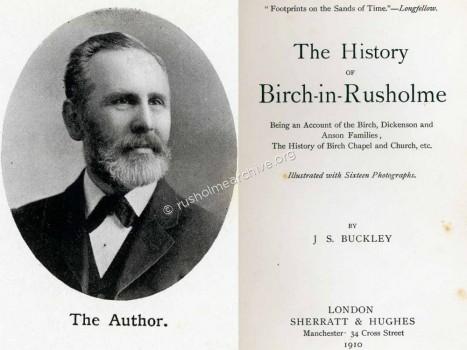
I have now scanned this book to a PDF file - look at the menu on the left.
Birch Hall description circa 1911

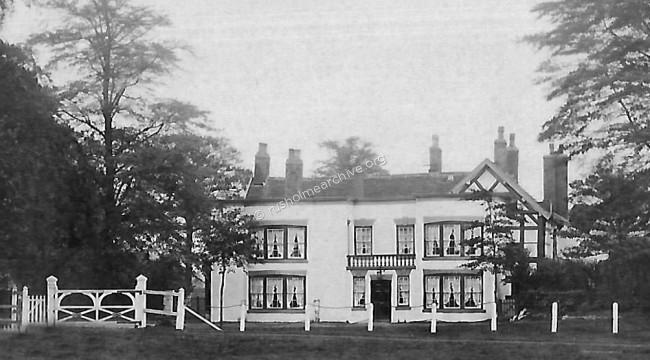
Birch Hall stands in a pleasant situation to the east of the church, well protected on three sides by trees, and overlooking Birch Fields on the north. The original site would seem to have been determined by a small brook, which still forms the boundary of the grounds of the hall on the south side. The house was originally a timber and plaster building of considerable extent, to judge from the list of rooms mentioned in an inventory taken in 1678, but the only portion now remaining has been so much modernized and added to that it presents little or nothing of its former appearance. It consists of two wings at right angles facing north and west, the latter of which appears to be part of a 17th-century building. A good deal of the timber construction of the outer walls, and the old roof, still remains, though the walls have been much restored and filled in with brickwork at a later time and new windows inserted. The west elevation and the end gable facing north, however, retain something of their old black and white appearance, though the gable has been mutilated by later work, and portion of the 'half-timber' framing is only plaster and paint. The north wing is of brick with stone quoins, and is probably a rebuilding of a former timber structure. In front of this, at a later time, most likely at the beginning of the 19th century, a new brick front, consisting of two rooms and entrance, has been added, projecting considerably in front of the north wing, and altogether altering the appearance of the house. The building is of two stories with grey stone slated roofs, and all the brickwork is painted yellow. In the west wing are three upper rooms with good 17th century oak wainscot, but the panelling is not all in its original position, and in one room is painted over. There is a small oak stair to an attic, and one or two old windows remain with diamond quarries. There are portions of 17th century woodwork in different parts of the house, the fittings of the old building no doubt being treated with little respect in the later alterations. These have been so effective that nothing very definite can be stated as to the original plan or arrangement of the house. There are brick outbuildings on the south side at the end of the west wing.
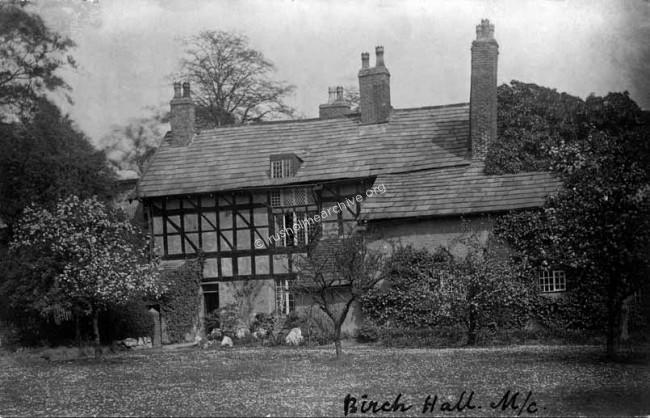
An inventory of 1678 refers to a number of rooms in the house, the final room bearing a curious, (by today's standards), name. 'In the inventory of goods of Colonel Thomas Birch at Birch Hall, 14 Aug. 1678, the following rooms are named:— The hall, the garden parlour, the white chamber, the middlemost room, the painted chamber, the dining room, the red chamber, Mrs. Birch's chamber, old Mrs. Birch's chamber, the yellow chamber, 'the old wench's chamber!'
The 19th century frontage.
The first illustration below is taken from William Royles 'History of Rusholme'. Not a very precise illustration but it does convey a certain atmosphere!
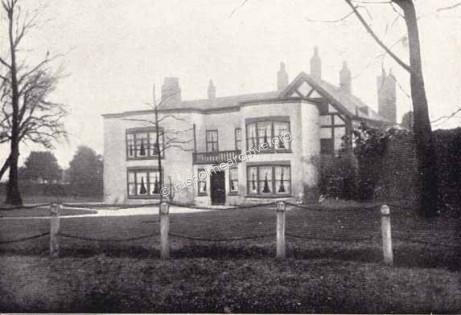
The photograph below is a fairly clear image, although rather dark. However it does seem the the 1911 description is reasonably accurate, 'the only portion now remaining has been so much modernized and added to that it presents little or nothing of its former appearance'
This photograph has been reproduced from the Manchester Central Library Archives & Local Studies dept. 'images' collection. I very much appreciate the permission granted to use this photograph.
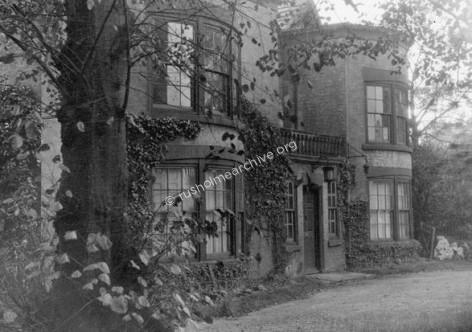
Birch Hall was finally demolished in 1926 and its former site is now in the grounds of Manchester Grammar School.
If you would like to see more images of Birch Hall follow the link below to the Manchester Library 'Images' collection and enter Birch Hall into the 'Search' box. Remember to press the back button on your browser to return this website
